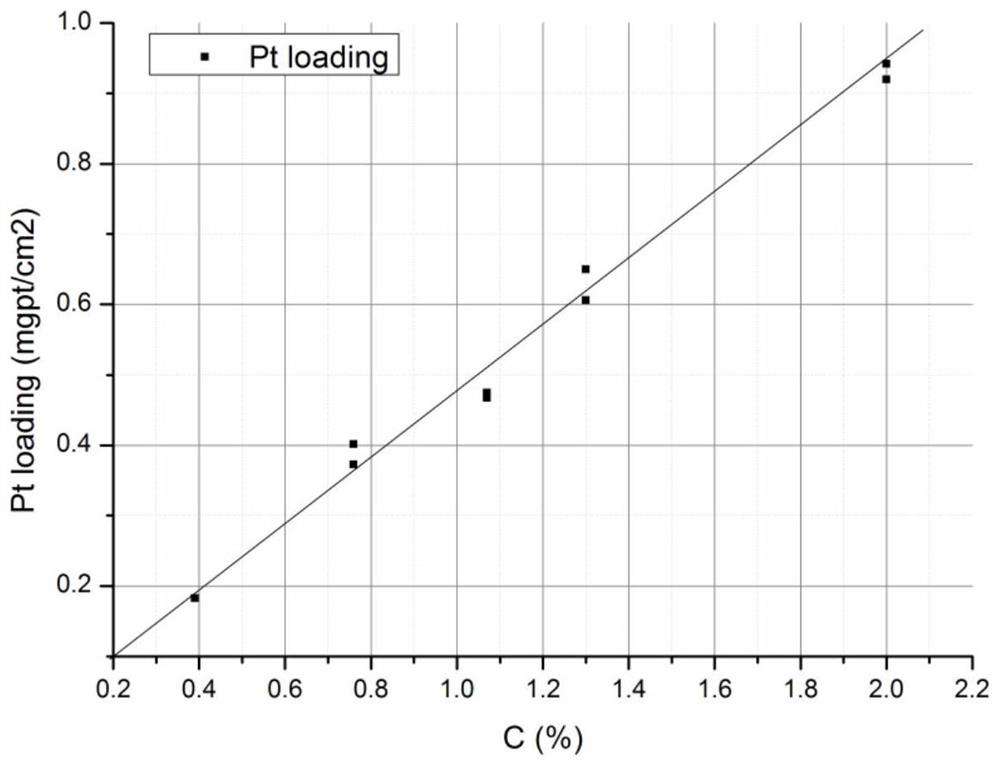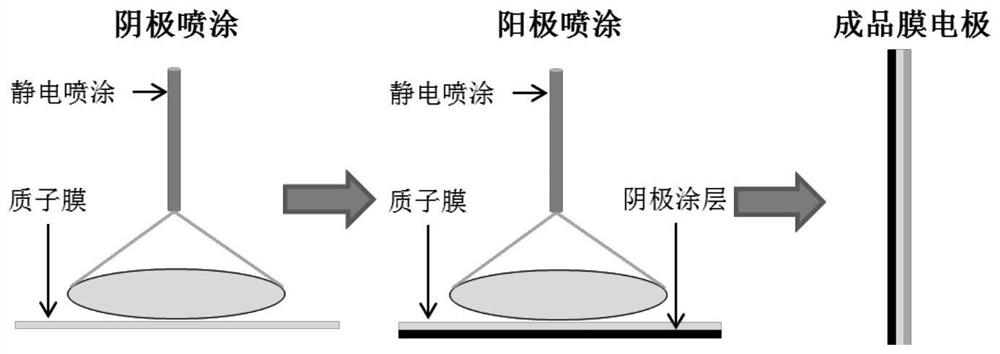A kind of membrane electrode and preparation method thereof
A membrane electrode and anode technology, applied in battery electrodes, circuits, fuel cells, etc., can solve problems such as uneven dispersion of catalyst particles, and achieve the effects of improving electrochemical performance, preventing agglomeration, and uniform and stable slurry
- Summary
- Abstract
- Description
- Claims
- Application Information
AI Technical Summary
Problems solved by technology
Method used
Image
Examples
preparation example Construction
[0065] The preparation method of the above-mentioned catalyst slurry is not particularly limited in the present invention, and the preparation is preferably completed by ultrasonic dispersion, and the ultrasonic time is preferably 25 minutes.
[0066] Then, the prepared slurry is coated on the proton membrane by using an electrostatic sprayer to make a membrane electrode.
[0067] The present invention also provides a preparation method for the above-mentioned membrane electrode, comprising the following steps:
[0068] The catalyst slurry is sprayed onto the surface of the proton exchange membrane by an electrostatic spraying process.
[0069] In the present invention, an electrostatic sprayer is preferably used for spraying, and the temperature of the vacuum chuck is preferably 90-100°C. This temperature can prevent secondary agglomeration of dispersed resin monomers. At the same time, under the condition of ensuring the performance of the battery, the preparation temperat...
Embodiment 1
[0076] The platinum-carbon catalyst (0.303g) containing platinum 46.5wt% was dispersed in a mixed solvent of 6mL deionized water and 12mL ethanol by ultrasonic to form a uniform suspension. Octylammonium was dissolved in 12mL ethanol solvent to form a cobalt nitrate solution, then the cobalt nitrate solution was added dropwise to the platinum-carbon suspension solution to form a mixed solution, the mixed solution was stirred, and the mixed solution was mixed while maintaining stirring Form a uniform solution, adjust the pH value to about 4, make the mixed solution acidic, and then pass an inert gas (such as nitrogen, helium or argon) into the mixed solution to remove oxygen for more than 1 hour.
[0077] Add 0.4 mL of hydrazine hydrate to the deoxygenated mixture, stir for 24 hours, wash the solid with deionized water and ethanol alternately, filter until the pH of the filtrate is neutral, and dry it in an oven at 60°C for 6 hours under the protection of an inert gas The prima...
Embodiment 2
[0082] 1. Preparation of catalyst slurry
[0083] Take a certain amount of the PtCo / C catalyst prepared in Example 1, add the catalyst, deionized water, Nafion solution, ethanol, isopropanol and dioxane in sequence, and the mass ratio of the above six components is 1:5:4:49 : 21:5. Wherein, I / C=0.75, carbon mass fraction=0.65%. After mixing, ultrasonically stir for 25 min.
[0084] 2. Electrostatic spraying
[0085] Set the temperature of the vacuum chuck to 95°C, and spread the proton exchange membrane on the vacuum chuck. Put the prepared slurry into the feed tank, adjust the parameters of the electrostatic sprayer, and control the Pt loading of the cathode catalytic layer at 0.3mg Pt / cm 2 , the anode Pt loading is 0.1mg Pt / cm 2 .
[0086] See the specific spraying process image 3 shown.
[0087] Figure 4 It is the SEM image of the catalytic layer formed after spraying (perpendicular to the direction of the proton membrane). Depend on Figure 4 It can be see...
PUM
 Login to View More
Login to View More Abstract
Description
Claims
Application Information
 Login to View More
Login to View More - R&D
- Intellectual Property
- Life Sciences
- Materials
- Tech Scout
- Unparalleled Data Quality
- Higher Quality Content
- 60% Fewer Hallucinations
Browse by: Latest US Patents, China's latest patents, Technical Efficacy Thesaurus, Application Domain, Technology Topic, Popular Technical Reports.
© 2025 PatSnap. All rights reserved.Legal|Privacy policy|Modern Slavery Act Transparency Statement|Sitemap|About US| Contact US: help@patsnap.com



